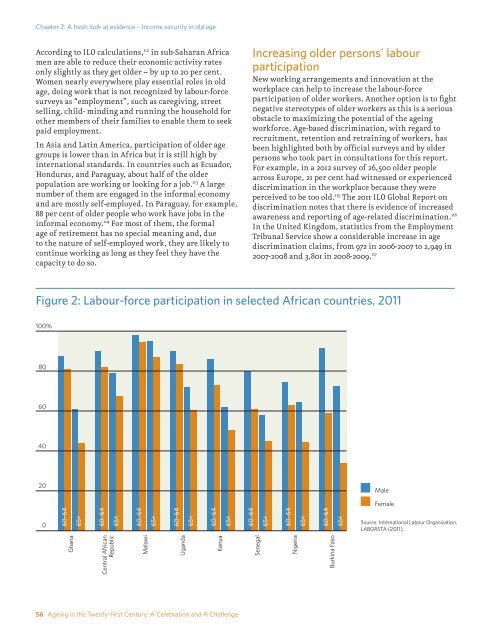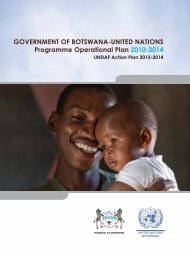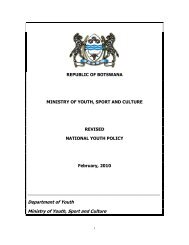Ageing in the Twenty-First Century: - HelpAge International
Ageing in the Twenty-First Century: - HelpAge International
Ageing in the Twenty-First Century: - HelpAge International
Create successful ePaper yourself
Turn your PDF publications into a flip-book with our unique Google optimized e-Paper software.
Chapter 2: A fresh look at evidence – Income security <strong>in</strong> old age<br />
Accord<strong>in</strong>g to ILO calculations, 112 <strong>in</strong> sub-Saharan Africa<br />
men are able to reduce <strong>the</strong>ir economic activity rates<br />
only slightly as <strong>the</strong>y get older – by up to 20 per cent.<br />
Women nearly everywhere play essential roles <strong>in</strong> old<br />
age, do<strong>in</strong>g work that is not recognized by labour-force<br />
surveys as “employment”, such as caregiv<strong>in</strong>g, street<br />
sell<strong>in</strong>g, child- m<strong>in</strong>d<strong>in</strong>g and runn<strong>in</strong>g <strong>the</strong> household for<br />
o<strong>the</strong>r members of <strong>the</strong>ir families to enable <strong>the</strong>m to seek<br />
paid employment.<br />
In Asia and Lat<strong>in</strong> America, participation of older age<br />
groups is lower than <strong>in</strong> Africa but it is still high by<br />
<strong>in</strong>ternational standards. In countries such as Ecuador,<br />
Honduras, and Paraguay, about half of <strong>the</strong> older<br />
population are work<strong>in</strong>g or look<strong>in</strong>g for a job. 113 A large<br />
number of <strong>the</strong>m are engaged <strong>in</strong> <strong>the</strong> <strong>in</strong>formal economy<br />
and are mostly self-employed. In Paraguay, for example,<br />
88 per cent of older people who work have jobs <strong>in</strong> <strong>the</strong><br />
<strong>in</strong>formal economy. 114 For most of <strong>the</strong>m, <strong>the</strong> formal<br />
age of retirement has no special mean<strong>in</strong>g and, due<br />
to <strong>the</strong> nature of self-employed work, <strong>the</strong>y are likely to<br />
cont<strong>in</strong>ue work<strong>in</strong>g as long as <strong>the</strong>y feel <strong>the</strong>y have <strong>the</strong><br />
capacity to do so.<br />
Increas<strong>in</strong>g older persons’ labour<br />
participation<br />
New work<strong>in</strong>g arrangements and <strong>in</strong>novation at <strong>the</strong><br />
workplace can help to <strong>in</strong>crease <strong>the</strong> labour-force<br />
participation of older workers. Ano<strong>the</strong>r option is to fight<br />
negative stereotypes of older workers as this is a serious<br />
obstacle to maximiz<strong>in</strong>g <strong>the</strong> potential of <strong>the</strong> age<strong>in</strong>g<br />
workforce. Age-based discrim<strong>in</strong>ation, with regard to<br />
recruitment, retention and retra<strong>in</strong><strong>in</strong>g of workers, has<br />
been highlighted both by official surveys and by older<br />
persons who took part <strong>in</strong> consultations for this report.<br />
For example, <strong>in</strong> a 2012 survey of 26,500 older people<br />
across Europe, 21 per cent had witnessed or experienced<br />
discrim<strong>in</strong>ation <strong>in</strong> <strong>the</strong> workplace because <strong>the</strong>y were<br />
perceived to be too old. 115 The 2011 ILO Global Report on<br />
discrim<strong>in</strong>ation notes that <strong>the</strong>re is evidence of <strong>in</strong>creased<br />
awareness and report<strong>in</strong>g of age-related discrim<strong>in</strong>ation. 116<br />
In <strong>the</strong> United K<strong>in</strong>gdom, statistics from <strong>the</strong> Employment<br />
Tribunal Service show a considerable <strong>in</strong>crease <strong>in</strong> age<br />
discrim<strong>in</strong>ation claims, from 972 <strong>in</strong> 2006-2007 to 2,949 <strong>in</strong><br />
2007-2008 and 3,801 <strong>in</strong> 2008-2009. 117<br />
apter 2, Figure 2: Labour force participation <strong>in</strong> selected African countries, 2011<br />
Figure 2: Labour-force participation <strong>in</strong> selected African countries, 2011<br />
100%<br />
80<br />
60<br />
40<br />
20<br />
Male<br />
Male<br />
0<br />
Female Female<br />
Source: <strong>International</strong> Labour Organization,<br />
LABORSTA Source: ILO, (2011). Laborstat, 2011<br />
Ghana<br />
Central African<br />
Republic<br />
Malawi<br />
Uganda<br />
Kenya<br />
Senegal<br />
Nigeria<br />
Burk<strong>in</strong>a Faso<br />
60–64<br />
65+<br />
60–64<br />
65+<br />
60–64<br />
65+<br />
60–64<br />
65+<br />
60–64<br />
65+<br />
60–64<br />
65+<br />
60–64<br />
65+<br />
60–64<br />
65+<br />
56 <strong>Age<strong>in</strong>g</strong> <strong>in</strong> <strong>the</strong> <strong>Twenty</strong>-<strong>First</strong> <strong>Century</strong>: A Celebration and A Challenge







